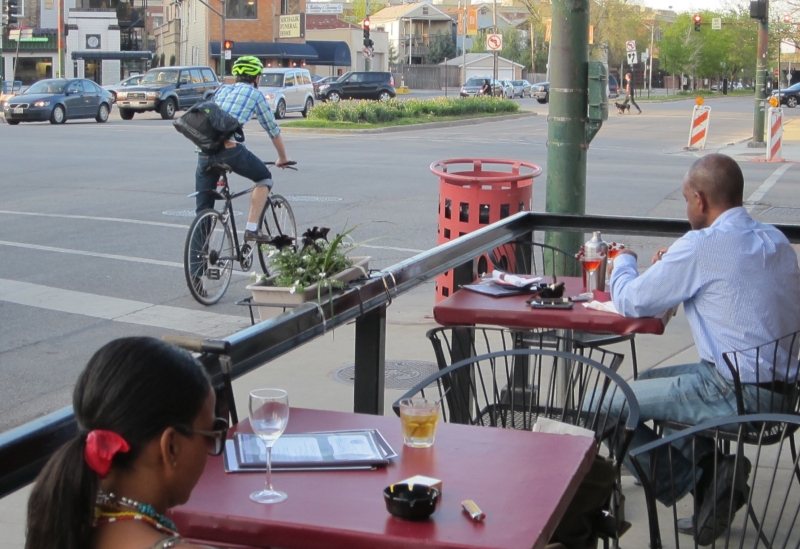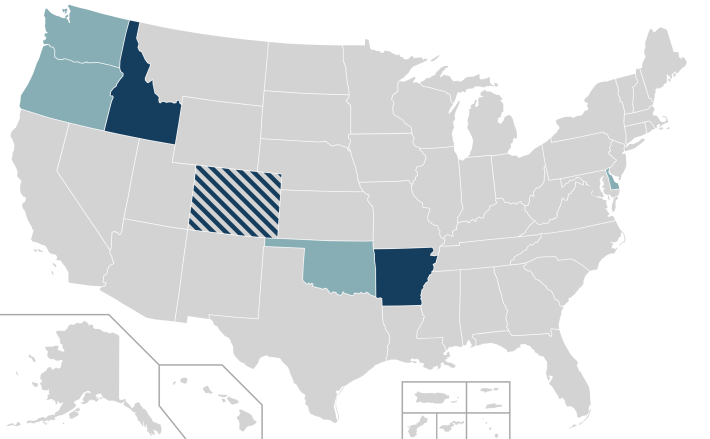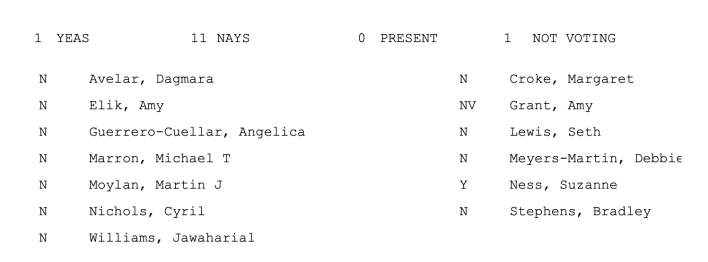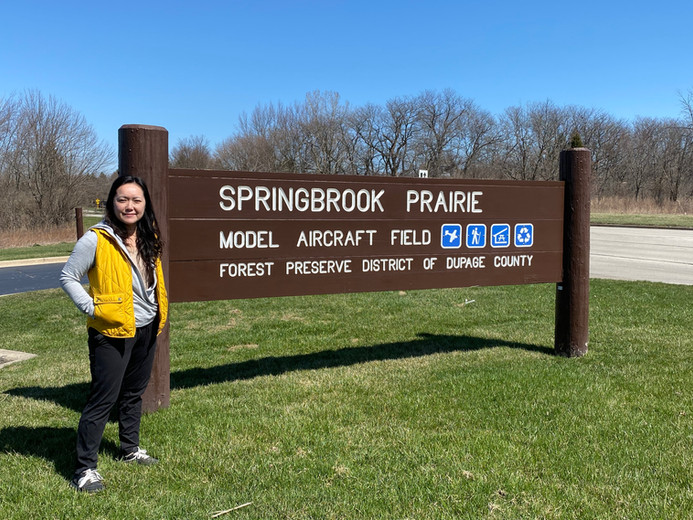Illinois lawmakers killed an “Idaho stop” bill this week, but one could pass in the future
6:17 PM CST on February 17, 2022

Almost all Chicago bike riders treat stoplights like stop signs, and stop signs like yield signs. Studies show that may actually be safer than following the letter of the current law. Photo: John Greenfield
Recently, I posted a Twitter thread explaining why the "Idaho stop" is such a common move among bike riders; why it's generally a safe and sensible way to ride; and why it should be legal. The term refers to people on bikes treating stop signs like yield signs, and/or treating stoplights like stop signs. It's important to note that it does not refer to blowing stop signs and reds on a bike without regard to pedestrians or cross traffic, which is obviously a dangerous and selfish thing to do.
The Idaho Stop got its name because in 1982 Idaho became the first state to legalize both these moves. Since then, several other states and municipalities have passed "stop sign as yield" and "red light as stop" laws.

A 2016 study by Chicago's DePaul University noted that, in addition to being a more efficient and convenient way to bike, the Idaho stop may actually be safer than following the letter of the law. For example, the researchers mentioned a 2007 Transport for London report that found that female cyclists in that city were fatally struck by turning truck drivers at much higher rates than men, apparently because women were more likely to wait for stoplights to change and get caught in the drivers’ blind spots.
The DePaul researchers observed 875 bike riders at six intersections on Chicago's North Side and in the Hyde Park neighborhood. They found that only one out of 25 cyclists came to a complete stop at stop signs, and two-thirds of riders proceed through stoplights if the intersection was clear. As such the report recommended that Chicago and other Illinois municipalities consider legalizing the Idaho stop.
Check out more discussion of why it makes sense to legalize the Idaho stop in my thread.
I'd be glad to explain why many, if not most, cyclists often treat stop signs like yield signs and stoplights like stop signs.
— John Greenfield (@greenfieldjohn) January 17, 2022
First let's acknowledge that mindlessly blowing either w/o regard to pedestrians or cross traffic is dangerous and d---ish.https://t.co/rmNHJrgoRs
By coincidence, on Tuesday a bill to legalize "stop sign as yield" in Illinois was voted down in the state legislature's transportation committee. HB4276 was sponsored by state representative Janet Yang Rohr (D-41) of southwest-suburban Naperville. The legislation states, "An individual operating a bicycle approaching a stop sign may proceed through the intersection without stopping if 1) the individual slows to a reasonable speed and 2) yields the right-of-way to any pedestrian within the intersection or an adjacent crosswalk; other traffic within the intersection; and oncoming traffic that poses an immediate hazard during the time the individual is traveling through the intersection." The bill specifies that the Idaho stop would not be legal at intersections with active railroad crossings.
The transportation committee vote against the legislation was nearly unanimous, with the sole supporter being Suzanne Ness (D-66), representing northwest suburbs like Elgin and Crystal Lake. Here's the voting roll.

Kyle Whitehead, spokesperson for Chicago's Active Transportation Alliance, said the advocacy group was not involved with the bill and is not currently advocating for legalizing the Idaho stop. "Right now we’re focused on strategies with greater potential to impact our mission to reduce crashes and encourage more walking, bicycling, and public transit use. This includes building more walking and biking infrastructure on state roads and giving cities the flexibility to reduce default speed limits. We continue to talk with legislators and community leaders about the long-term potential to legalize the Idaho Stop in Illinois."
Dave Simmons, executive director of the statewide advocacy organization Ride Illinois said he was aware of HB4276, but his organization was not contacted by Yang Rohr or otherwise involved. "While this topic has been discussed within Ride Illinois and with partners, we’re not currently advocating for... [an] Idaho Stop law in Illinois. Our current time and energy related to legislation is directed towards the main asks at the federal level that we’ll be advocating for at the National Bike Summit at the end of March." He said it's possible the group may lobby for the Idaho stop in the future.

Yang Rohr said the idea for the Idaho stop law came from her constituents. "We have a lot of passionate and casual bike riders in Naperville." Now that she lives in the suburbs, she mostly bikes for recreation in a local forest preserve. But she said that when she lived in Chicago's Lakeview neighborhood and didn't own a car, she regularly rode to her downtown office via the Lakefront Trail.
When Yang Rohr's staffers researched the Idaho stop, they found evidence that the policy may have increased safety and decreased injuries in other states. A 2009 study found there had been a 14.5 percent decrease in bike injuries since the 1982 legalization of the Idaho Stop in the Gem State. Meanwhile in Delaware, a state-run report on the "Delaware Yield" law (stop sign as yield) found that, comparing the 30 months before the October 2017 passage of the law with the 30 months after it, injury crashes at stop sign intersections dropped by 23 percent.
Yang Rohr noted that the Idaho stop "allows cyclists to clear intersections more quickly and safely." In addition, she said, low-traffic bike routes on side streets often have lots of stop signs, so rather than have to put their foot down at every block, killing their momentum, some cyclists may instead ride on main streets as a more efficient alternative. "So the legalizing the Idaho stop would encourage people to use safer, lower-traffic routes."
Ultimately Yang Rohr decided to simply call for for stop sign as yield instead of including "red light as stop" in her legislation. "I figured, let's do one step at a time, and if this passes and we can show a similar reduction in injuries as other states, maybe in the future it would make sense to pass stoplights as well."
So if legalizing the Idaho stop is such logical idea, why did Yang Rohr's colleagues kill the bill? "It's not totally intuitive," she said. "More education of the committee members is needed. I'm not totally surprised because in some other states it took years to pass."
Even in bike-friendly California, passing an Idaho stop law has been an uphill battle. Last October California governor Gavin Newsom, who's facing a reelection battle this year, disregarded the evidence and vetoed the Bicycle Safety Stop bill, which would have legalized stop sign as yield, despite support for the law from a broad coalition of legislators and advocates.
While Yang Rohr can't reintroduce her bill this year, she said she might give it another go in the future, perhaps recruiting the Active Transportation alliance and Ride Illinois to advocate for it. "The good thing is, we started a dialogue and started a process of people learning why this law may make sense in the future."
Thanks to Streetsblog Chicago sponsor Keating Law Offices for notifying us about the Illinois legislation.
In addition to editing Streetsblog Chicago, John writes about transportation and other topics for additional local publications. A Chicagoan since 1989, he enjoys exploring the city on foot, bike, bus, and 'L' train.
Read More:
Stay in touch
Sign up for our free newsletter
More from Streetsblog Chicago
Which Metra corridor would become more bike-friendly and greener under a new plan? Ravenswood!
Thanks to plans to convert little-used parking spaces, the avenue is slated to get a new bike lane, and the Winnslie Parkway path and garden will be extended south.
They can drive 25: At committee meeting residents, panelist support lowering Chicago’s default speed limit
While there's no ordinance yet, the next steps are to draft one, take a committee vote and, if it passes, put it before the full City Council.


